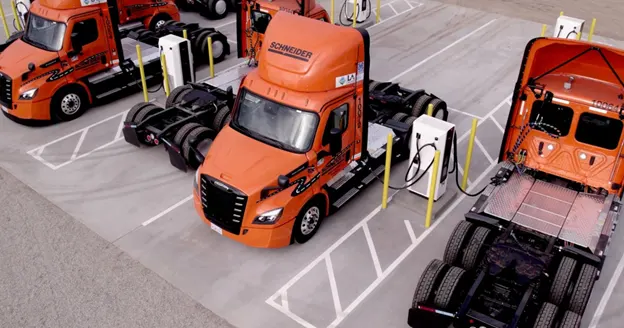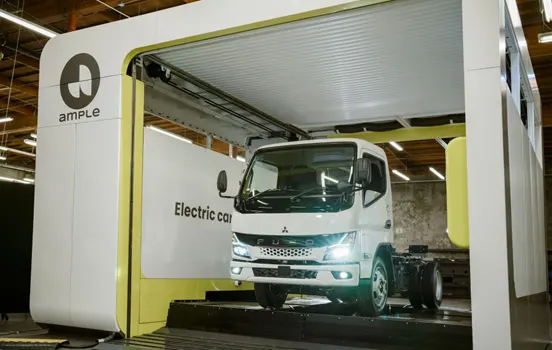
Charging vs. Battery Swapping: Which Will Power the Future of Electric Heavy Trucks?
The demand for new energy vehicles (NEVs) continues to rise, and the market for electric medium and heavy-duty trucks has seen significant growth since 2020. In this rapidly expanding segment, pure electric technology currently leads the way. However, the debate between the two main recharging methods—charging and battery swapping—remains ongoing. So, which one is likely to dominate the future?
Current Challenges for Electric Heavy Trucks
Both charging and battery swapping face the challenge of “limited range” for pure electric medium and heavy-duty trucks. These vehicles are primarily used in controlled environments and short-distance, high-frequency transportation markets. Each method offers distinct advantages and disadvantages, which we’ll explore below.
Battery Swapping: Quick Recharge, High Infrastructure Costs
Battery swapping offers a compelling solution to the range anxiety often associated with EVs. By replacing a depleted battery with a fully charged one, this method allows for rapid replenishment comparable to refueling a traditional diesel truck. This can be particularly beneficial for commercial fleets operating on tight schedules, such as those involved in urban delivery or short-haul transportation.
ADVANTAGES:
- Rapid recharge: Battery swaps can be completed in 3-5 minutes, comparable to refueling diesel trucks.
- Battery as a service: Users can rent batteries, reducing upfront costs and shifting battery management to operators.
- Improved battery life: Dedicated battery management can extend battery lifespan and enhance safety. Off-peak charging also reduces costs.
DISADVANTAGES
- High infrastructure costs: Building swapping stations requires high costs and complex procedures for land approval and grid connection.
- Standardization challenges: Lack of standardized battery packs limits compatibility across different vehicle models most stations serve only one vehicle model.
- Technological advancements: Rapid battery technology evolution demands frequent station upgrades, posing operational risks.
- Operational efficiency: Quick replenishment may not always be realized due to the need to charge swapped batteries, requiring effective management to minimize wait times.
Charging: Mature Technology, Longer Recharge Times
While battery swapping offers rapid recharging, traditional charging remains a viable option for many electric heavy trucks. This method involves connecting the vehicle to a charging station, where electricity is transferred to the battery. While charging times are generally longer than battery swapping, this approach offers several advantages.
ADVANTAGES:
- Mature technology: Well-established and widely adopted.
- Versatility: Compatible with various vehicle models and sizes.
- Lower infrastructure costs: Charging stations are generally less expensive to build and maintain compared to swapping stations.
- Technological advancements: Rapid charging capabilities are improving, reducing charging times.
DISADVANTAGES
- Longer recharge times: Even with fast charging, replenishing battery capacity takes longer than battery swapping.
- Higher vehicle costs: Electric trucks often have higher purchase prices due to battery costs.
- Battery degradation: Battery performance declines over time, impacting range and
increasing long-term expenses.

Which Method Wins? It Depends!
The choice between charging and battery swapping for electric heavy trucks is not one-size-fits-all. The ideal solution depends on different factors, including:
Route Characteristics
Battery swapping is often the preferred method for routes that involve short distances with high-frequency stops. The ability to quickly swap batteries ensures minimal downtime and keeps the vehicle in continuous operation. For longer routes with fewer stops, charging may be more suitable. Vehicles can be charged during scheduled breaks or overnight, making it easier to maintain the battery’s charge without frequent interruptions.
Infrastructure Availability
The availability and density of charging stations are critical. In regions with a well-established network of charging stations, charging becomes a more viable option, especially if fast-charging technology is accessible. Similarly, the presence of battery swapping stations is essential for this method to be effective. Areas with a high concentration of swapping stations enable seamless battery exchanges and reduce the risk of downtime.
Vehicle Utilization
Vehicles that are in constant use, such as those in logistics and delivery services, benefit greatly from battery swapping. The ability to quickly swap batteries allows these vehicles to remain operational for longer periods without needing extended downtime for charging.
Total Cost of Ownership
The cost of batteries is a significant factor in the total cost of ownership. Battery swapping can reduce upfront costs by allowing operators to rent batteries rather than purchase them outright. Aside from that, the costs associated with building and maintaining charging infrastructure must be considered. While charging stations are generally less expensive to establish than swapping stations, the ongoing operational costs, including energy prices in the area and maintenance must also be considered.
The Future of Electric Heavy Trucks
While both charging and battery swapping have their strengths, a hybrid approach combining elements of both could emerge. Additionally, technological advancements in battery technology, charging infrastructure, and energy management systems will continue to shape the industry.
Ultimately, the successful adoption of electric heavy trucks will require a combination of factors, including government support, industry collaboration, and consumer acceptance. As technology progresses and infrastructure improves, the electric commercial vehicle market is poised for significant growth.
Meta Description: Explore the future of electric heavy trucks with an in-depth comparison of charging vs. battery swapping. Discover the pros and cons of each method, including route suitability, infrastructure needs, vehicle utilization, and total cost of ownership. Understand how these factors influence the optimal recharging solution for your fleet as the electric truck industry continues to evolve.
